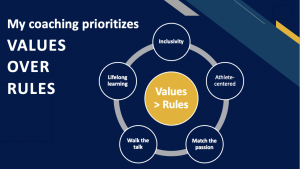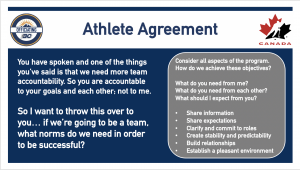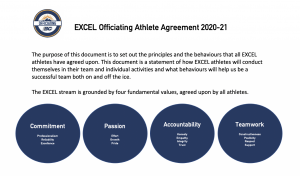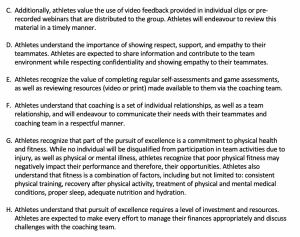One of the highlights of my autumn (that didn’t have a lot of positives) was the opportunity to gather our seven EXCEL (NextGen) officials for a training camp in October. Technology has been a lifesaver during this pandemic; however, technology has limits. Friends, colleagues, athletes (and myself, as well) have reported being “zoomed out” pretty consistently from July onwards. Therefore, I felt it was critical for us to gather in-person prior to re-focus ahead of a highly disrupted season.
 The training camp was 52 hours of intense physical and mental training that could not have been accomplished remotely but the one piece that I want to focus on in this post is the creation of our first athlete agreement. This is not something that I had embarked upon previously because my coaching context is so diverse: I’m working day-to-day with individuals from sixteen to forty-five years of age across the Train to Train, Train to Compete, and Competitive for Life contexts. Under those diverse circumstances, it’s difficult to come to a shared understanding. However, I don’t want to coach in a context where I am the one driving the expectations because ultimately, it is the athletes who have to do the work and it is their conceptions of success or failure that drive our program goals and my coaching goals.
The training camp was 52 hours of intense physical and mental training that could not have been accomplished remotely but the one piece that I want to focus on in this post is the creation of our first athlete agreement. This is not something that I had embarked upon previously because my coaching context is so diverse: I’m working day-to-day with individuals from sixteen to forty-five years of age across the Train to Train, Train to Compete, and Competitive for Life contexts. Under those diverse circumstances, it’s difficult to come to a shared understanding. However, I don’t want to coach in a context where I am the one driving the expectations because ultimately, it is the athletes who have to do the work and it is their conceptions of success or failure that drive our program goals and my coaching goals.
So with that in mind, our EXCEL group was an opportunity create an athlete agreement that would actually bind the group together in a useful way as we move forward. Our EXCEL athletes have similar goals, along the lines of achieving success in international competition. The similarity of their goals and the level of commitment required to achieve those goals lend themselves to the creation of an athlete agreement. Entering into the weekend, we set aside several hours on both Saturday and Sunday to address the athlete agreement. In talking with my assistant coach, we had two key goals:
- Clarify and commit to group values

- Express those values in terms concrete behaviours
- Provide a basis for communication and resolution of conflict throughout the season
- Create a document to ground the program as athlete-centred and guided by values, rather than rules, as detailed in my coaching philosophy
When we gathered in camp, I explained the task. I explained that my actions were guided by my core value and my purpose. So the objective of building the athlete agreement was to create a foundational document that would guide our program towards each individual achieving their goals both inside and outside of sport.

I pre-loaded the group with some background and some reflective questions, as I have detailed above, to provide some guidance. For this exercise, I chose a “nominal group” facilitation technique (NCCP, Coaching and Leading Effectively: Reference material, 27). I decided this would be the best method because we have some strong personalities as well as some more deferential personalities within the group. So if I used a more open facilitation technique, certain individuals would likely dominate the conversation. So, during this process, everyone wrote down their ideas individually and then they shared out their ideas one at a time, going around the room until everyone had said their piece. As we did this, we grouped certain ideas together or eliminated certain ideas that were better expressed in other ways. We started with values and then moved on to concrete behaviours. During this process, we had a couple of interesting moments…
As I predicted, this process brought some simmering resentment between individuals to the surface. There was pre-existing conflict within the team about perceived differences in level of commitment and level of effort. I was glad that it was coming to the surface under these circumstances because there was a very clear end goal. When the conflict started to bubble up and the group shifted away from the production of an athlete agreement, I could re-direct it back to the task at hand, so the session didn’t turn into an airing of grievances. Whenever the conflict threatened to take over the session, I would offer a simple redirect: “ok, so what is the ideal behaviour and how can we reflect that in a written agreement?” And then, I would step into the background and allow the conversation to resume. This worked exactly as I had hoped because the level of conflict (NCCP, Managing Conflict: Reference material, 7) was not personal in nature. It was a conflict over facts or goals (what was done or what should be done), rather than methods or values. Ultimately, there was widespread agreement in regards to collective values and the ability to express that agreement in a collective setting filled in those “cracks” and left the foundation stronger, rather than “papering over them” and leaving vulnerabilities within the group unaddressed.
 The other thing that occurred in moments of conflict was that two of the athletes in the group, who I would categorize as being “less outspoken” than others, fell back on the communication model of a “I see; I think; I feel; I need” message (Coaching and Leading Effectively, 19), which I first introduced at our High Performance Training Camp (all 40 athletes from across the province) in August 2019. I was totally blown away by this because while I believe in the efficacy of this technique, it always seems a little hokey to be practicing and roleplaying a technique like this. So while everyone participated in the exercise and some mentioned it in their feedback forms, there was no way for me to tell whether or not anyone had actually taken this to heart. So it was extremely validating that, in a moment of challenge, where I might have expected individuals to shrink away from interpersonal conflict, they a) rose to the occasion and didn’t back away; b) engaged with a technique that I introduced to the group over a year ago; and c) they were able to deliver a message respectfully and effectively, in a way that contributed value to the conversation.
The other thing that occurred in moments of conflict was that two of the athletes in the group, who I would categorize as being “less outspoken” than others, fell back on the communication model of a “I see; I think; I feel; I need” message (Coaching and Leading Effectively, 19), which I first introduced at our High Performance Training Camp (all 40 athletes from across the province) in August 2019. I was totally blown away by this because while I believe in the efficacy of this technique, it always seems a little hokey to be practicing and roleplaying a technique like this. So while everyone participated in the exercise and some mentioned it in their feedback forms, there was no way for me to tell whether or not anyone had actually taken this to heart. So it was extremely validating that, in a moment of challenge, where I might have expected individuals to shrink away from interpersonal conflict, they a) rose to the occasion and didn’t back away; b) engaged with a technique that I introduced to the group over a year ago; and c) they were able to deliver a message respectfully and effectively, in a way that contributed value to the conversation.
Throughout the hours that we spent working on this exercise, my only contributions were as a secretary and an occasional guidepost to keep the group on-track. It also gave us the opportunity, without the usual distractions of phones ringing or games being played, to really engage with each other and interrogate the big-picture questions: “what do we value? what do we want? how do we get those things?” I don’t think that anyone’s goals changed over the course of the camp (because everyone is pretty set in their determination to succeed before they enter the EXCEL stream) but they certainly thought about those questions on a deeper level and that level of thought is enshrined in the agreement. Following our camp, I recorded the agreement, provided the opportunity to final feedback, and then it was agreed upon by our seven athletes and two coaches.
Our EXCEL group is comprised of competitive individuals who set extremely high standards for themselves. Moreover, the goals these individuals have set for themselves mean that we will likely be engaged with one another over the next decade or so. Because the nature of competitive sport is that you will fail far more often than you succeed, there will be disappointment and conflict within the group. I firmly believe that conflict is not inherently negative (NCCP, Managing Conflict: Reference material, 2). However, in order for that to be true, there must be an overall structure to help focus our conflict. My hope was that the athlete agreement will be a mechanism for that. When we have a conflict, we refer back to the values and behaviours outlined in the agreement and use that as the basis for resolving said conflict. More importantly, we now have a strong base that will govern every interaction that we have as individuals and a group, that will allow us to focus on achieving success both on and off the ice.

A snippet of our athlete agreement
